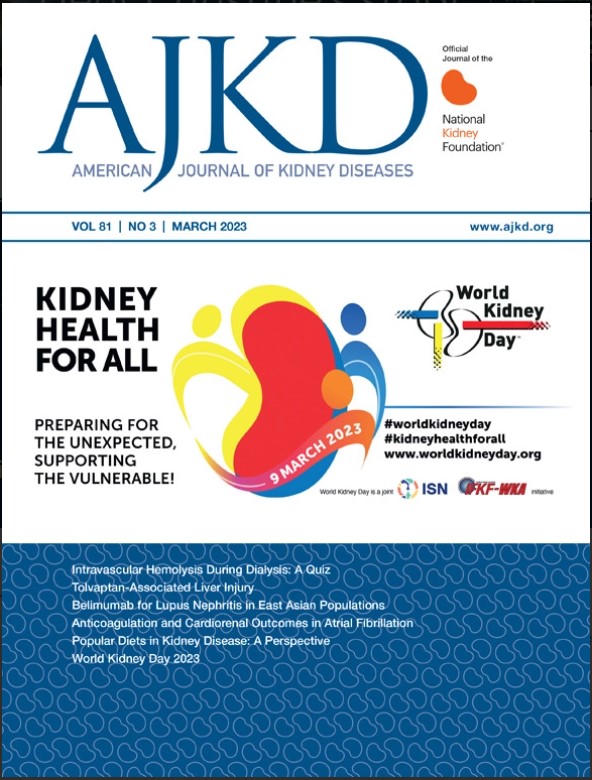在美国肾脏分配系统下,种族和民族与高寿命死亡捐献者肾脏移植的关系。
IF 9.4
1区 医学
Q1 UROLOGY & NEPHROLOGY
引用次数: 0
摘要
理由与目标:美国肾脏分配系统(KAS)优先考虑移植后估计存活率(EPTS)≤20%的肾脏捐献者,其肾脏捐献者档案指数(KDPI)≤20%的肾脏捐献者可获得高寿命肾脏。在 KAS 中使用 EPTS 会降低年龄较大、患有糖尿病和透析时间较长的候选者的优先级。研究设计:观察性队列研究:观察性队列研究:研究设计:观察性队列研究.环境:& 参与者:2015 年 1 月至 2020 年 12 月期间在肾移植受者科学登记处登记的肾移植成年候选者和受者.暴露:& 种族和民族.结果:& 种族和民族:种族和民族:分析方法:多变量逻辑回归:分析方法:多变量逻辑回归、Fine-Gray竞争风险生存分析、Kaplan-Meier和Cox比例危害法:队列中包括 199,444 名列入死亡供体肾移植名单的候选者(7% 亚裔、29% 黑人、19% 西班牙裔/拉丁美洲裔、43% 白人)。与白人相比,非白人患者的糖尿病患病率明显更高、透析时间更长且更年轻。经年龄调整后,亚裔、黑人和西班牙裔/拉丁裔候选者的 ETPS 评分≤20% 的几率明显较低(OR 0.86,[0.81,0.91],0.52 [0.50,0.54],0.49,[0.47,0.51]),与白人候选者相比,接受≤20% KDPI 肾脏的可能性较低(subHR 0.70 [0.66,0.75],0.89 [0.87,0.92] 和 0.73 [0.71,0.76])。与白人受者相比,EPTS评分≤20%的受者移植了KDPI≤20%的死者供肾,其中亚裔和西班牙裔受者的移植后死亡率较低(HR为0.45 [0.27,0.77] 和0.63 [0.47,0.86]),黑人受者的移植后死亡率较高,但无统计学意义(HR为1.22 [0.99,1.52]):局限性:提供者报告的种族族裔数据和移植后5年随访期:结论:美国肾脏分配系统不太可能将少数种族候选者识别为EPTS得分≤20%的人,而EPTS得分≤20%会触发高寿命已故捐献者肾脏的分配。这些研究结果将为 OPTN 提供信息,说明如何纠正 KAS 目前将预测寿命较长的同种异体移植物分配给估计移植后存活期较长的受者的方法所带来的种族/民族差异。本文章由计算机程序翻译,如有差异,请以英文原文为准。
Association of Race and Ethnicity With High Longevity Deceased Donor Kidney Transplantation Under the US Kidney Allocation System
Rationale & Objective
The US Kidney Allocation System (KAS) prioritizes candidates with a ≤20% estimated posttransplant survival (EPTS) to receive high-longevity kidneys defined by a ≤20% Kidney Donor Profile Index (KDPI). Use of EPTS in the KAS deprioritizes candidates with older age, diabetes, and longer dialysis durations. We assessed whether this use also disadvantages race and ethnicity minority candidates, who are younger but more likely to have diabetes and longer durations of kidney failure requiring dialysis.
Study Design
Observational cohort study.
Setting & Participants
Adult candidates for and recipients of kidney transplantation represented in the Scientific Registry of Transplant Recipients from January 2015 through December 2020.
Exposure
Race and ethnicity.
Outcome
Age-adjusted assignment to ≤20% EPTS, transplantation of a ≤20% KDPI kidney, and posttransplant survival in longevity-matched recipients by race and ethnicity.
Analytic Approach
Multivariable logistic regression, Fine-Gray competing risks survival analysis, and Kaplan-Meier and Cox proportional hazards methods.
Results
The cohort included 199,444 candidates (7% Asian, 29% Black, 19% Hispanic or Latino, and 43% White) listed for deceased donor kidney transplantation. Non-White candidates had significantly higher rates of diabetes, longer dialysis duration, and were younger than White candidates. Adjusted for age, Asian, Black, and Hispanic or Latino candidates had significantly lower odds of having a ETPS score of ≤20% (odds ratio, 0.86 [95% CI, 0.81-0.91], 0.52 [95% CI, 0.50-0.54], and 0.49 [95% CI, 0.47-0.51]), and were less likely to receive a ≤20% KDPI kidney (sub-hazard ratio, 0.70 [0.66-0.75], 0.89 [0.87-0.92], and 0.73 [0.71-0.76]) compared with White candidates. Among recipients with ≤20% EPTS scores transplanted with a ≤20% KDPI deceased donor kidney, Asian and Hispanic recipients had lower posttransplant mortality (HR, 0.45 [0.27-0.77] and 0.63 [0.47-0.86], respectively) and Black recipients had higher but not statistically significant posttransplant mortality (HR, 1.22 [0.99-1.52]) compared with White recipients.
Limitations
Provider reported race and ethnicity data and 5-year post transplant follow-up period.
Conclusions
The US kidney allocation system is less likely to identify race and ethnicity minority candidates as having a ≤20% EPTS score, which triggers allocation of high-longevity deceased donor kidneys. These findings should inform the Organ Procurement and Transplant Network about how to remedy the race and ethnicity disparities introduced through KAS’s current approach of allocating allografts with longer predicted longevity to recipients with longer estimated posttransplant survival.
Plain-Language Summary
The US Kidney Allocation System prioritizes giving high-longevity, high-quality kidneys to patients on the waiting list who have a high estimated posttransplant survival (EPTS) score. EPTS is calculated based on the patient’s age, whether the patient has diabetes, whether the patient has a history of organ transplantation, and the number of years spent on dialysis. Our analyses show that Asian, Black or African American, and Hispanic or Latino patients were less likely to receive high-longevity kidneys compared with White patients, despite having similar or better posttransplant survival outcomes.
求助全文
通过发布文献求助,成功后即可免费获取论文全文。
去求助
来源期刊

American Journal of Kidney Diseases
医学-泌尿学与肾脏学
CiteScore
20.40
自引率
2.30%
发文量
732
审稿时长
3-8 weeks
期刊介绍:
The American Journal of Kidney Diseases (AJKD), the National Kidney Foundation's official journal, is globally recognized for its leadership in clinical nephrology content. Monthly, AJKD publishes original investigations on kidney diseases, hypertension, dialysis therapies, and kidney transplantation. Rigorous peer-review, statistical scrutiny, and a structured format characterize the publication process. Each issue includes case reports unveiling new diseases and potential therapeutic strategies.
 求助内容:
求助内容: 应助结果提醒方式:
应助结果提醒方式:


